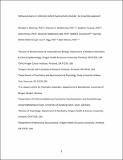Files in this item
Pathway analysis in attention deficit hyperactivity disorder : an ensemble approach
Item metadata
| dc.contributor.author | Mooney, Michael A | |
| dc.contributor.author | McWeeney, Shannon K | |
| dc.contributor.author | Faraone, Stephen V | |
| dc.contributor.author | Hinney, Anke | |
| dc.contributor.author | Hebebrand, Johannes | |
| dc.contributor.author | IMAGE2 Consortium | |
| dc.contributor.author | German ADHD GWAS Group | |
| dc.contributor.author | Nigg, Joel T | |
| dc.contributor.author | Wilmot, Beth | |
| dc.date.accessioned | 2017-03-23T00:33:12Z | |
| dc.date.available | 2017-03-23T00:33:12Z | |
| dc.date.issued | 2016-09 | |
| dc.identifier | 242397641 | |
| dc.identifier | 0a82a75a-e580-4f7a-8614-0f746db2173c | |
| dc.identifier | 27004716 | |
| dc.identifier | 84961615785 | |
| dc.identifier.citation | Mooney , M A , McWeeney , S K , Faraone , S V , Hinney , A , Hebebrand , J , IMAGE2 Consortium , German ADHD GWAS Group , Nigg , J T & Wilmot , B 2016 , ' Pathway analysis in attention deficit hyperactivity disorder : an ensemble approach ' , American Journal of Medical Genetics. Part B, Neuropsychiatric Genetics , vol. 171 , no. 6 , pp. 815-826 . https://doi.org/10.1002/ajmg.b.32446 | en |
| dc.identifier.issn | 1552-4841 | |
| dc.identifier.other | ORCID: /0000-0002-5315-3399/work/60195342 | |
| dc.identifier.uri | https://hdl.handle.net/10023/10510 | |
| dc.description | © 2016 Wiley Periodicals, Inc. | en |
| dc.description.abstract | Despite a wealth of evidence for the role of genetics in attention deficit hyperactivity disorder (ADHD), specific and definitive genetic mechanisms have not been identified. Pathway analyses, a subset of gene-set analyses, extend the knowledge gained from genome-wide association studies (GWAS) by providing functional context for genetic associations. However, there are numerous methods for association testing of gene sets and no real consensus regarding the best approach. The present study applied six pathway analysis methods to identify pathways associated with ADHD in two GWAS datasets from the Psychiatric Genomics Consortium. Methods that utilize genotypes to model pathway-level effects identified more replicable pathway associations than methods using summary statistics. In addition, pathways implicated by more than one method were significantly more likely to replicate. A number of brain-relevant pathways, such as RhoA signaling, glycosaminoglycan biosynthesis, fibroblast growth factor receptor activity, and pathways containing potassium channel genes, were nominally significant by multiple methods in both datasets. These results support previous hypotheses about the role of regulation of neurotransmitter release, neurite outgrowth and axon guidance in contributing to the ADHD phenotype and suggest the value of cross-method convergence in evaluating pathway analysis results. | |
| dc.format.extent | 465243 | |
| dc.language.iso | eng | |
| dc.relation.ispartof | American Journal of Medical Genetics. Part B, Neuropsychiatric Genetics | en |
| dc.subject | ADHD | en |
| dc.subject | Pathway analyses | en |
| dc.subject | GWAS | en |
| dc.subject | RA0421 Public health. Hygiene. Preventive Medicine | en |
| dc.subject | RJ101 Child Health. Child health services | en |
| dc.subject | NDAS | en |
| dc.subject | SDG 3 - Good Health and Well-being | en |
| dc.subject.lcc | RA0421 | en |
| dc.subject.lcc | RJ101 | en |
| dc.title | Pathway analysis in attention deficit hyperactivity disorder : an ensemble approach | en |
| dc.type | Journal article | en |
| dc.contributor.institution | University of St Andrews. School of Medicine | en |
| dc.contributor.institution | University of St Andrews. Institute of Behavioural and Neural Sciences | en |
| dc.identifier.doi | 10.1002/ajmg.b.32446 | |
| dc.description.status | Peer reviewed | en |
| dc.date.embargoedUntil | 2017-03-22 |
This item appears in the following Collection(s)
Items in the St Andrews Research Repository are protected by copyright, with all rights reserved, unless otherwise indicated.

